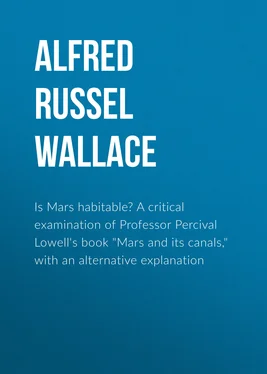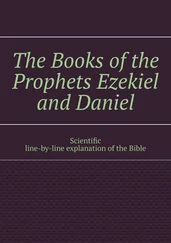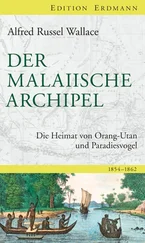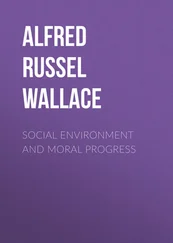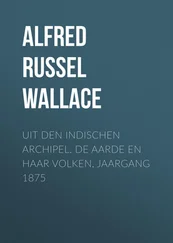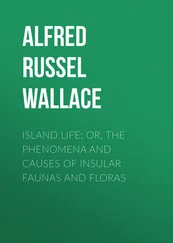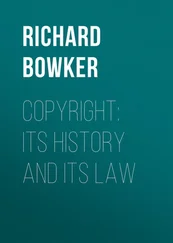Alfred Wallace - Is Mars habitable? A critical examination of Professor Percival Lowell's book Mars and its canals, with an alternative explanation
Здесь есть возможность читать онлайн «Alfred Wallace - Is Mars habitable? A critical examination of Professor Percival Lowell's book Mars and its canals, with an alternative explanation» — ознакомительный отрывок электронной книги совершенно бесплатно, а после прочтения отрывка купить полную версию. В некоторых случаях можно слушать аудио, скачать через торрент в формате fb2 и присутствует краткое содержание. Издательство: Иностранный паблик, Жанр: foreign_edu, Физика, на английском языке. Описание произведения, (предисловие) а так же отзывы посетителей доступны на портале библиотеки ЛибКат.
- Название:Is Mars habitable? A critical examination of Professor Percival Lowell's book Mars and its canals, with an alternative explanation
- Автор:
- Издательство:Иностранный паблик
- Жанр:
- Год:неизвестен
- ISBN:нет данных
- Рейтинг книги:5 / 5. Голосов: 1
-
Избранное:Добавить в избранное
- Отзывы:
-
Ваша оценка:
- 100
- 1
- 2
- 3
- 4
- 5
Is Mars habitable? A critical examination of Professor Percival Lowell's book Mars and its canals, with an alternative explanation: краткое содержание, описание и аннотация
Предлагаем к чтению аннотацию, описание, краткое содержание или предисловие (зависит от того, что написал сам автор книги «Is Mars habitable? A critical examination of Professor Percival Lowell's book Mars and its canals, with an alternative explanation»). Если вы не нашли необходимую информацию о книге — напишите в комментариях, мы постараемся отыскать её.
Is Mars habitable? A critical examination of Professor Percival Lowell's book Mars and its canals, with an alternative explanation — читать онлайн ознакомительный отрывок
Ниже представлен текст книги, разбитый по страницам. Система сохранения места последней прочитанной страницы, позволяет с удобством читать онлайн бесплатно книгу «Is Mars habitable? A critical examination of Professor Percival Lowell's book Mars and its canals, with an alternative explanation», без необходимости каждый раз заново искать на чём Вы остановились. Поставьте закладку, и сможете в любой момент перейти на страницу, на которой закончили чтение.
Интервал:
Закладка:
The Canals as described by Mr. Lowell.
In the clear atmosphere of Arizona, Mr. Lowell has been able on various favourable occasions to detect a network of straight lines, meeting or crossing each other at various angles, and often extending to a thousand or even over two thousand miles in length. They are seen to cross both the light and the dark regions of the planet's surface, often extending up to or starting from the polar snow-caps. Most of these lines are so fine as only to be visible on special occasions of atmospheric clearness and steadiness, which hardly ever occur at lowland stations, even with the best instruments, and almost all are seen to be as perfectly straight as if drawn with a ruler.
The Double Canals.
Under exceptionally favourable conditions, many of the lines that have been already seen single appear double—a pair of equally fine lines exactly parallel throughout their whole length, and appearing, as Mr. Lowell says, "clear cut upon the disc, its twin lines like the rails of a railway track." Both Schiaparelli and Lowell were at first so surprised at this phenomenon that they thought it must be an optical illusion, and it was only after many observations in different years, and by the application of every conceivable test, that they both became convinced that they witnessed a real feature of the planet's surface. Mr. Lowell says he has now seen them hundreds of times, and that his first view of one was 'the most startlingly impressive' sight he has ever witnessed.
Dimensions of the Canals.
A few dimensions of these strange objects must be given in order that readers may appreciate their full strangeness and inexplicability. Out of more than four hundred canals seen and recorded by Mr. Lowell, fifty-one, or about one eighth, are either constantly or occasionally seen to be double, the appearance of duplicity being more or less periodical. Of 'canals' generally, Mr. Lowell states that they vary in length from a few hundred to a few thousand miles long, one of the largest being the Phison, which he terms 'a typical double canal,' and which is said to be 2250 miles long, while the distance between its two constituents is about 130 miles. 3 3 This is on the opposite side of Mars from that shown in the frontispiece.
The actual width of each canal is from a minimum of about a mile up to several miles, in one case over twenty. A great feature of the doubles is, that they are strictly parallel throughout their whole course, and that in almost all cases they are so truly straight as to form parts of a great circle of the planet's sphere. A few however follow a gradual but very distinct curve, and such of these as are double present the same strict parallelism as those which are straight.
Canals extend across the Seas.
It was only after seventeen years of observation of the canals that it was found that they extended also into and across the dark spots and surfaces which by the earlier observers were termed seas, and which then formed the only clearly distinguishable and permanent marks on the planet's surface. At the present time, Professor Lowell states that this "curious triangulation has been traced over almost every portion of the planet's surface, whether dark or light, whether greenish, ochre, or brown in colour." In some parts they are much closer together than in others, "forming a perfect network of lines and spots, so that to identify them all was a matter of extreme difficulty." Two such portions are figured at pages 247 and 256 of Mr. Lowell's volume.
The Oases.
The curious circular black spots which are seen at the intersections of many of the canals, and which in some parts of the surface are very numerous, are said to be more difficult of detection than even the lines, being often blurred or rendered completely invisible by slight irregularities in our own atmosphere, while the canals themselves continue visible. About 180 of these have now been found, and the more prominent of them are estimated to vary from 75 to 100 miles in diameter. There are however many much smaller, down to minute and barely visible black points. Yet they all seem a little larger than the canals which enter them. Where the canals are double, the spots (or 'oases' as Mr. Lowell terms them) lie between the two parallel canals.
No one can read this book without admiration for the extreme perseverance in long continued and successful observation, the results of which are here recorded; and I myself accept unreservedly the substantial accuracy of the whole series. It must however always be remembered that the growth of knowledge of the detailed markings has been very gradual, and that much of it has only been seen under very rare and exceptional conditions. It is therefore quite possible that, if at some future time a further considerable advance in instrumental power should be made, or a still more favourable locality be found, the new discoveries might so modify present appearances as to render a satisfactory explanation of them more easy than it is at present.
But though I wish to do the fullest justice to Mr. Lowell's technical skill and long years of persevering work, which have brought to light the most complex and remarkable appearances that any of the heavenly bodies present to us, I am obliged absolutely to part company with him as regards the startling theory of artificial production which he thinks alone adequate to explain them. So much is this the case, that the very phenomena, which to him seem to demonstrate the intervention of intelligent beings working for the improvement of their own environment, are those which seem to me to bear the unmistakable impress of being due to natural forces, while they are wholly unintelligible as being useful works of art. I refer of course to the great system of what are termed 'canals,' whether single or double. Of these I shall give my own interpretation later on.
CHAPTER III.
THE CLIMATE AND PHYSIOGRAPHY OF MARS
Mr. Lowell admits, and indeed urges strongly, that there are no permanent bodies of water on Mars; that the dark spaces and spots, thought by the early observers to be seas, are certainly not so now, though they may have been at an earlier period; that true clouds are rare, even if they exist, the appearances that have been taken for them being either dust-storms or a surface haze; that there is consequently no rain, and that large portions (about two-thirds) of the planet's surface have all the characteristics of desert regions.
Snow-caps the only Source of Water.
This state of things is supposed to be ameliorated by the fact of the polar snows, which in the winter cover the arctic and about half the temperate regions of each hemisphere alternately. The maximum of the northern snow-caps is reached at a period of the Martian winter corresponding to the end of February with us. About the end of March the cap begins to shrink in size (in the Northern Hemisphere), and this goes on so rapidly that early in the June of Mars it is reduced to its minimum. About the same time changes of colour take place in the adjacent darker portions of the surface, which become at first bluish, and later a decided blue-green; but by far the larger portion, including almost all the equatorial regions of the planet, remain always of a reddish-ochre tint. 4 4 In 1890 at Mount Wilson, California, Mr. W.H. Pickering's photographs of Mars on April 9th showed the southern polar cap of moderate dimensions, but with a large dim adjacent area. Twenty-four hours later a corresponding plate showed this same area brilliantly white; the result apparently of a great Martian snowfall. In 1882 the same observer witnessed the steady disappearance of 1,600,000 square miles of the southern snow-cap, an area nearly one-third of that hemisphere of the planet.
Интервал:
Закладка:
Похожие книги на «Is Mars habitable? A critical examination of Professor Percival Lowell's book Mars and its canals, with an alternative explanation»
Представляем Вашему вниманию похожие книги на «Is Mars habitable? A critical examination of Professor Percival Lowell's book Mars and its canals, with an alternative explanation» списком для выбора. Мы отобрали схожую по названию и смыслу литературу в надежде предоставить читателям больше вариантов отыскать новые, интересные, ещё непрочитанные произведения.
Обсуждение, отзывы о книге «Is Mars habitable? A critical examination of Professor Percival Lowell's book Mars and its canals, with an alternative explanation» и просто собственные мнения читателей. Оставьте ваши комментарии, напишите, что Вы думаете о произведении, его смысле или главных героях. Укажите что конкретно понравилось, а что нет, и почему Вы так считаете.
